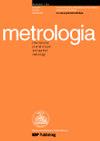PAWG pilot study on quantification of total haemoglobin in blood
IF 2.4
3区 工程技术
Q2 INSTRUMENTS & INSTRUMENTATION
引用次数: 0
Abstract
Under the auspices of the Protein Analysis Working Group (PAWG) of the Comité Consultatif pour la Quantité de Matière (CCQM) a pilot study, CCQM-P201, was organised. Five National Metrology Institutes (NMIs) participated in this pilot study and provided a total of eleven measurement results using six different methods based on three different measurement principles. The purpose of this pilot study was to develop measurement capabilities for the accurate quantification of intact haemoglobin (Hb) whereby measurement results could be made directly traceable to the SI. The choice of protein resulted from its ability to be quantified via different measurement principles providing different routes of traceability. Hb also provided a model of an intact protein with a complex tetrameric structure which is often measured via quantification of a specific subunit or the incorporated haem group. To achieve appropriate results for the chosen measurand, it was necessary to distinguish between the whole protein and fragments of the tetrameric structure, such as dimers or monomers. The participants were encouraged to investigate several of the measurement methods available. This was considered particularly advantageous in this instance as various methods applied to the same analyte may assist in identifying possible previously unknown biases or interferences of the various methods. Hb is being used as a model system to build capacity in methods for the quantification of proteins with a molar mass ≤ 100 kDa in biological fluids in a concentration range > 1∙106 pmol/g. This was the first pilot study for the quantification of an inherent protein in blood with all the natural variations that protein shows in a clinical sample. The different methods applied by the participants included isotopic dilution (ID) organic mass spectrometry (MS) of specific peptides after tryptic digestion, species-specific ID inductively coupled plasma mass spectrometry (ICP-MS), post-column ID ICP-MS, quantification via total iron after chromatographic isolation of Hb and acid digestion as well as two optical methods. One of the latter was the reference method proposed by the International Committee for Standardisation in Haematology (ICSH) based on the conversion of Hb to hemiglobincyanide (HiCN), the other used the conversion of Hb with alkaline haematin detergent both followed by the measurement of spectroscopic absorbance. Considering the use of very different measurement techniques for the quantification of total Hb, the results are in good agreement with a reference value with corresponding expanded uncertainty of (120.6 ± 1.2) mg/g calculated as DerSimonian-Laird mean. However, the observed differences between the results are not completely reflected in the reported measurement uncertainties. The calculated interlaboratory standard deviation or Tau value (dark uncertainty) was approximately 3 % whilst the average reported measurement uncertainty was approximately half this (1.4 %). A possible reason for this large difference may lie in the underestimation of any necessary conversion factors and their uncertainty contributions, between the target analyte measured and the requested measurand. To reach the main text of this paper, click on Final Report. Note that this text is that which appears in Appendix B of the BIPM key comparison database https://www.bipm.org/kcdb/. The final report has been peer-reviewed and approved for publication by the CCQM, according to the provisions of the CIPM Mutual Recognition Arrangement (CIPM MRA).PAWG 关于血液中总血红蛋白定量的试点研究
在材料定量咨询委员会(CCQM)蛋白质分析工作组(PAWG)的支持下,组织了一项名为 CCQM-P201 的试点研究。五个国家计量机构(NMI)参加了这项试点研究,并根据三种不同的测量原则,使用六种不同的方法提供了总共 11 项测量结果。这项试点研究的目的是开发精确定量完整血红蛋白(Hb)的测量能力,使测量结果可以直接溯源到 SI。之所以选择蛋白质,是因为它能够通过不同的测量原理进行量化,从而提供不同的溯源途径。Hb 还提供了一个具有复杂四聚体结构的完整蛋白质模型,通常通过对特定亚基或结合的血红素基团进行定量测量。为了获得所选测量剂的适当结果,有必要区分整个蛋白质和四聚体结构的片段,如二聚体或单体。我们鼓励学员研究几种可用的测量方法。在这种情况下,他们认为这样做特别有利,因为对同一分析物采用不同的方法可能有助于确定各种方法中可能存在的先前未知的偏差或干扰。血红蛋白被用作一个模型系统,用于建立生物液体中摩尔质量≤ 100 kDa 的蛋白质的定量方法能力,其浓度范围 > 1∙106 pmol/g。这是首次对血液中的固有蛋白质进行定量的试验性研究,因为蛋白质在临床样本中会出现各种自然变化。参与者采用的不同方法包括:胰蛋白酶消化后特定肽的同位素稀释(ID)有机质谱(MS)、物种特异性 ID 电感耦合等离子体质谱(ICP-MS)、柱后 ID ICP-MS、通过色谱分离 Hb 和酸消化后的总铁进行定量,以及两种光学方法。其中一种是由国际血液学标准化委员会(ICSH)提出的参考方法,该方法基于将 Hb 转化为血红蛋白氰化物(HiCN),另一种则使用碱性血清洗涤剂将 Hb 转化,然后测量光谱吸光度。考虑到总血红蛋白的定量使用了截然不同的测量技术,结果与参考值非常吻合,相应的扩大不确定度为 (120.6 ± 1.2) mg/g,计算方法为 DerSimonian-Laird 平均值。然而,观察到的结果之间的差异并没有完全反映在报告的测量不确定度中。计算得出的实验室间标准偏差或 Tau 值(暗不确定度)约为 3%,而报告的平均测量不确定度约为其一半(1.4%)。造成这种巨大差异的一个可能原因是低估了所测量的目标分析物与所要求的测量物之间的任何必要转换因子及其不确定性贡献。要阅读本文正文,请点击最终报告。请注意,该文本是 BIPM 关键比对数据库 https://www.bipm.org/kcdb/ 附录 B 中的文本。根据 CIPM 互认安排 (CIPM MRA) 的规定,最终报告已由 CCQM 进行同行评审并批准出版。
本文章由计算机程序翻译,如有差异,请以英文原文为准。
求助全文
约1分钟内获得全文
求助全文
来源期刊

Metrologia
工程技术-物理:应用
CiteScore
2.80
自引率
25.00%
发文量
137
审稿时长
12 months
期刊介绍:
Published 6 times per year, Metrologia covers the fundamentals of measurements, particularly those dealing with the seven base units of the International System of Units (metre, kilogram, second, ampere, kelvin, candela, mole) or proposals to replace them.
The journal also publishes papers that contribute to the solution of difficult measurement problems and improve the accuracy of derived units and constants that are of fundamental importance to physics.
In addition to regular papers, the journal publishes review articles, issues devoted to single topics of timely interest and occasional conference proceedings. Letters to the Editor and Short Communications (generally three pages or less) are also considered.
 求助内容:
求助内容: 应助结果提醒方式:
应助结果提醒方式:


